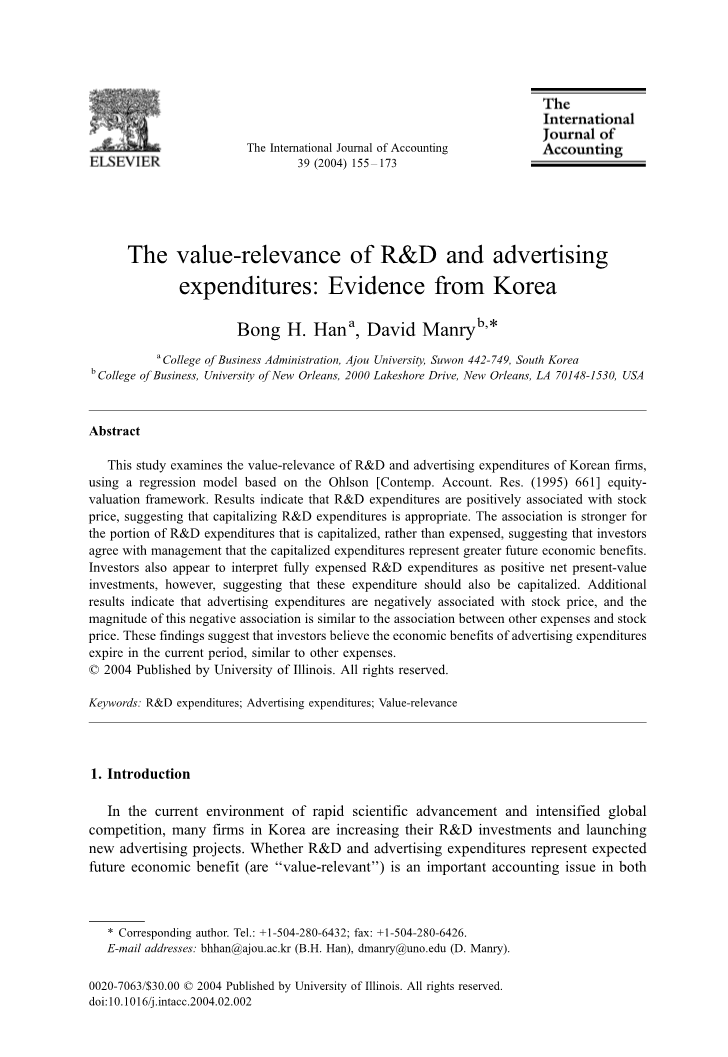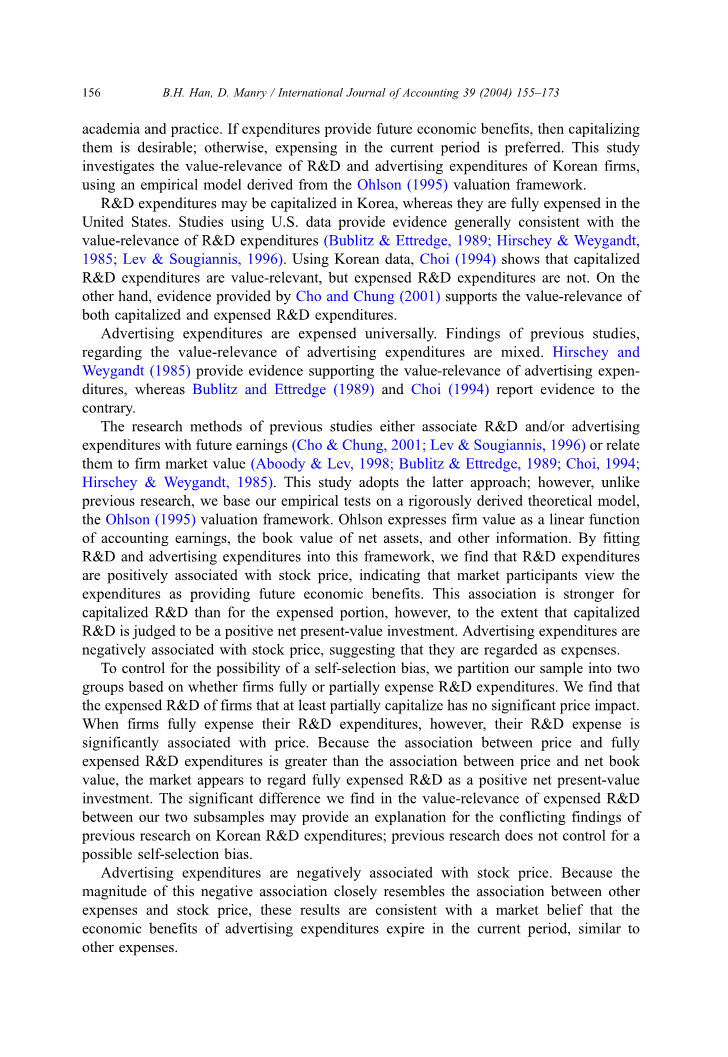

英语原文共 19 页,剩余内容已隐藏,支付完成后下载完整资料
论企业期间费用管理存在的问题及对策
The value-relevance of Ramp;D and advertising expenditures: Evidence from Korea
Bong H. Hana, David Manry
Abstract
This study examines the value-relevance of Ramp;D and advertising expenditures of Korean firms, using a regression model based on the Ohlson [Contemp. Account. Res. (1995) 661] equityvaluation framework. Results indicate that Ramp;D expenditures are positively associated with stock price, suggesting that capitalizing Ramp;D expenditures is appropriate. The association is stronger for the portion of Ramp;D expenditures that is capitalized, rather than expensed, suggesting that investors agree with management that the capitalized expenditures represent greater future economic benefits.
Investors also appear to interpret fully expensed Ramp;D expenditures as positive net present-value investments, however, suggesting that these expenditure should also be capitalized. Additional results indicate that advertising expenditures are negatively associated with stock price, and the magnitude of this negative association is similar to the association between other expenses and stock price. These findings suggest that investors believe the economic benefits of advertising expenditures expire in the current period, similar to other expenses.Introduction
In the current environment of rapid scientific advancement and intensified global competition, many firms in Korea are increasing their Ramp;D investments and launching new advertising projects. Whether Ramp;D and advertising expenditures represent expected future economic benefit (are lsquo;lsquo;value-relevantrsquo;rsquo;) is an important accounting issue in both academia and practice. If expenditures provide future economic benefits, then capitalizing them is desirable; otherwise, expensing in the current period is preferred. This study investigates the value-relevance of Ramp;D and advertising expenditures of Korean firms, using an empirical model derived from the Ohlson (1995) valuation framework.
Ramp;D expenditures may be capitalized in Korea, whereas they are fully expensed in the
United States. Studies using U.S. data provide evidence generally consistent with the value-relevance of Ramp;D expenditures (Bublitz amp; Ettredge, 1989; Hirschey amp; Weygandt, 1985; Lev amp; Sougiannis, 1996). Using Korean data, Choi (1994) shows that capitalized Ramp;D expenditures are value-relevant, but expensed Ramp;D expenditures are not. On the other hand, evidence provided by Cho and Chung (2001) supports the value-relevance of both capitalized and expensed Ramp;D expenditures.
The research methods of previous studies either associate Ramp;D and/or advertising expenditures with future earnings (Cho amp; Chung, 2001; Lev amp; Sougiannis, 1996) or relate them to firm market value (Aboody amp; Lev, 1998; Bublitz amp; Ettredge, 1989; Choi, 1994; Hirschey amp; Weygandt, 1985). This study adopts the latter approach; however, unlike previous research, we base our empirical tests on a rigorously derived theoretical model, the Ohlson (1995) valuation framework. Ohlson expresses firm value as a linear function of accounting earnings, the book value of net assets, and other information. By fitting Ramp;D and advertising expenditures into this framework, we find that Ramp;D expenditures are positively associated with stock price, indicating that market participants view the expenditures as providing future economic benefits. This association is stronger for capitalized Ramp;D than for the expensed portion, however, to the extent that capitalized Ramp;D is judged to be a positive net present-value investment. Advertising expenditures are negatively associated with stock price, suggesting that they are regarded as expenses.
To control for the possibility of a self-selection bias, we partition our sample into two groups based on whether firms fully or partially expense Ramp;D expenditures. We find that the expensed Ramp;D of firms that at least partially capitalize has no significant price impact. When firms fully expense their Ramp;D expenditures, however, their Ramp;D expense is significantly associated with price. Because the association between price and fully expensed Ramp;D expenditures is greater than the association between price and net book value, the market appears to regard fully expensed Ramp;D as a positive net present-value investment. The significant difference we find in the value-relevance of expensed Ramp;D between our two subsamples may provide an explanation for the conflicting findings of previous research on Korean Ramp;D expenditures; previous research does not control for a possible self-selection bias.
Advertising expenditures are negatively associated with stock price. Because the magnitude of this negative association closely resembles the association between other expenses and stock price, these results are consistent with a market belief that the economic benefits of advertising expenditures expire in the current period, similar to other expenses.
The financial press has been critical of various Korean accounting practices, including the capitalization of amounts that do not represent future benefits (Ehrlich amp; Mann, 1998). Ramp;D investments and advertising activities are essential for securing a firmrsquo;s technological superiority and enhancing its brand values. Our findings on the information content of Ramp;D and advertising expenditures may prove useful in future deliberations about, on modifying current accounting standards that govern the extent to which these expenditures should be capitalized.
The next section discusses previous research and the Korean accounting standards that govern Ramp;D expenditures. Section 3 covers th
全文共29353字,剩余内容已隐藏,支付完成后下载完整资料
资料编号:[9922],资料为PDF文档或Word文档,PDF文档可免费转换为Word


